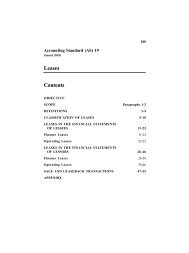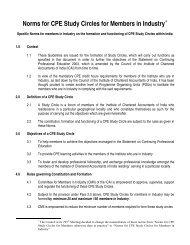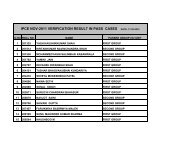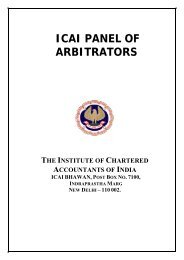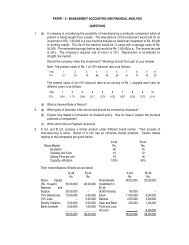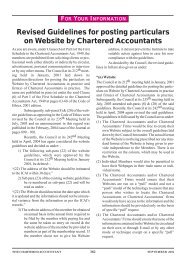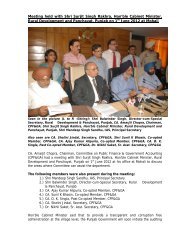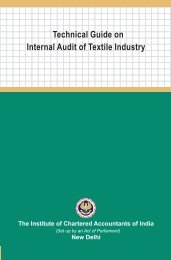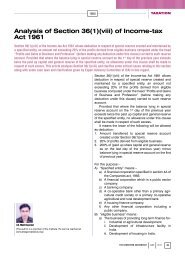The Chartered Accountant
The Chartered Accountant
The Chartered Accountant
Create successful ePaper yourself
Turn your PDF publications into a flip-book with our unique Google optimized e-Paper software.
asis but, in the auditor’s judgment,<br />
management’s use of the going concern<br />
assumption in the financial statements<br />
is inappropriate, the auditor<br />
shall express an adverse opinion. (Ref:<br />
Para. A25-A26)<br />
Management Unwilling to Make<br />
or Extend Its Assessment<br />
22. If management is unwilling to<br />
make or extend its assessment when<br />
requested to do so by the auditor, the<br />
auditor shall consider the implications<br />
for the auditor’s report. (Ref: Para. A27)<br />
Communication with Those<br />
Charged with Governance<br />
23. Unless all those charged with<br />
governance are involved in managing<br />
the entity, the auditor shall communicate<br />
with those charged with governance<br />
events or conditions identified<br />
that may cast significant doubt on the<br />
entity’s ability to continue as a going<br />
concern. Such communication with<br />
those charged with governance shall<br />
include the following:<br />
(a) Whether the events or conditions<br />
constitute a material uncertainty;<br />
(b) Whether the use of the going<br />
concern assumption is appropriate<br />
in the preparation and<br />
presentation of the financial<br />
statements; and<br />
(c) <strong>The</strong> adequacy of related disclosures<br />
in the financial statements.<br />
Significant Delay in the Approval<br />
of Financial Statements<br />
24. When there is significant delay in<br />
the approval of the financial statements<br />
by management or those charged with<br />
governance after the date of the financial<br />
statements, the auditor shall inquire<br />
as to the reasons for the delay. When the<br />
auditor believes that the delay could be<br />
related to events or conditions relating<br />
to the going concern assessment, the<br />
auditor shall perform those additional<br />
audit procedures necessary, as described<br />
in paragraph 16, as well as consider the<br />
effect on the auditor’s conclusion regarding<br />
the existence of a material uncertainty,<br />
as described in paragraph 17.<br />
Application and Other Explanatory<br />
Material<br />
Introduction<br />
DECEMBER 2008 1104 THE CHARTERED ACCOUNTANT<br />
STANDARDS<br />
Going Concern Assumption<br />
(Ref: Para. 2)<br />
A1. In some enterprises, for example,<br />
those where the funding arrangements<br />
are guaranteed by the Central Government,<br />
going concern risks may arise,<br />
but are not limited to, situations where<br />
such type of entities operate on a forprofit<br />
basis, where government support<br />
may be reduced or withdrawn,<br />
or in the case of privatisation. Events<br />
or conditions that may cast significant<br />
doubt on an entity’s ability to continue<br />
as a going concern may include situations<br />
where such type of entity lacks<br />
funding for its continued existence or<br />
when policy decisions are made that<br />
affect the services provided by such<br />
an entity.<br />
Risk Assessment Procedures and<br />
Related Activities<br />
Events or Conditions That May<br />
Cast Doubt about Going Concern<br />
Assumption (Ref: Para. 10)<br />
A2. <strong>The</strong> following are examples of<br />
events or conditions that, individually<br />
or collectively, may cast significant<br />
doubt about the going concern assumption.<br />
This listing is not all-inclusive<br />
nor does the existence of one or<br />
more of the items always signify that<br />
a material uncertainty exists.<br />
Financial<br />
l Net liability or net current liability<br />
position.<br />
l Fixed-term borrowings approaching<br />
maturity without realistic<br />
prospects of renewal or<br />
repayment; or excessive reliance<br />
on short-term borrowings to finance<br />
long-term assets.<br />
l Indications of withdrawal of<br />
financial support by creditors.<br />
l Negative operating cash flows<br />
indicated by historical or prospective<br />
financial statements.<br />
l Adverse key financial ratios.<br />
l Substantial operating losses or<br />
significant deterioration in the<br />
value of assets used to generate<br />
cash flows.<br />
l Arrears or discontinuance of<br />
dividends.<br />
l Inability to pay creditors on due<br />
dates.<br />
l Inability to comply with the<br />
terms of loan agreements.<br />
l Change from credit to cash-ondelivery<br />
transactions with suppliers.<br />
l Inability to obtain financing for<br />
essential new product development<br />
or other essential investments.<br />
Operating<br />
l Management intentions to liquidate<br />
the entity or to cease operations.<br />
l Loss of key management without<br />
replacement.<br />
l Loss of a major market, key<br />
customer(s), franchise, license,<br />
or principal supplier(s).<br />
l Labour difficulties.<br />
l Shortages of important supplies.<br />
l Emergence of a highly successful<br />
competitor.<br />
Other<br />
l Non-compliance with capital or<br />
other statutory requirements.<br />
l Pending legal or regulatory<br />
proceedings against the entity<br />
that may, if successful, result in<br />
claims that the entity is unlikely<br />
to be able to satisfy.<br />
l Changes in law or regulation or<br />
government policy expected to<br />
adversely affect the entity.<br />
l Uninsured or underinsured catastrophes<br />
when they occur.<br />
<strong>The</strong> significance of such events or<br />
conditions often can be mitigated by<br />
other factors. For example, the effect<br />
of an entity being unable to make its<br />
normal debt repayments may be counter-balanced<br />
by management’s plans to<br />
maintain adequate cash flows by alternative<br />
means, such as by disposing of<br />
assets, rescheduling loan repayments,<br />
or obtaining additional capital. Similarly,<br />
the loss of a principal supplier<br />
may be mitigated by the availability of<br />
a suitable alternative source of supply.<br />
A3. <strong>The</strong> risk assessment procedures<br />
required by paragraph 10 help the auditor<br />
to determine whether management’s<br />
use of the going concern assumption<br />
is likely to be an important<br />
issue and its impact on planning the<br />
audit. <strong>The</strong>se procedures also allow for<br />
more timely discussions with manage-



